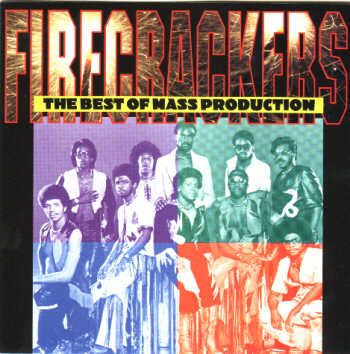 INNER CITY By Mass Production 1982
INNER CITY By Mass Production 1982
on Firecrackers The best of
Mass Production RHINO R2 75222 (1996)
Although they never achieved the notoriety they deserved, pound for pound Mass
Production was one of the hardest-working outfits in pop/R&B's heady era of
self-contained funk bands.
It was also one of the largest. In a pop music genre where a five-ember outfit could
have easily been considered a combo, Mass Production, sometimes standing I I members
strong (including Agnes "Tiny" Kelly, lead vocals and vocoder; Larry
"Rockstarr" Marshall, lead vocals; Rodney "Bunny" Phelps, lead guitar
and keyboards; LeCoy "Coy" Bryant, guitar; Tyrone Williams, keyboard; Kevin
"D' No" Douglas, bass guitar keyboards, and vocals; Ricardo "Ricky"
Williams, drums, percussion, keyboards and vocals Emmanuel "Joe Rock"
Redding, percussion; James "Otiste" Drumgole, trumpet, flugelhorn, and
vocals; Gregory McCoy, sex and keyboards; and Samuel "The Banger"
Williams, drums), was just short of an orchestra.
Formed in the early '70s in Norfolk, Virginia, Mass Production was inspired by
many of the successful R&B bands of the day, including Earth, Wind &
Fire, Commodores, George Clinton's P-Funk aggregation, Bar-Kays, and Cameo.
While some funk band aficionados remember Mass Production as the vehicle of
multitalented Tyrone Williams and lead
vocalisi/songwriter/drummer/percussionist Ricardo Williams, the band was a virtual
workshop of capable players and writers. Music entrepreneur Ed A. Ellerbe
actually jump-started the crew (through six albums, he would serve either as the
group's producer, manager, and/or executive producer): he brought the unit to the
attention of Cotillion records chief Henry Allen, who, eager to make a foray into
R&B's burgeoning funk movement, signed the group to his Atlantic-distributed label.
It's safe to say that at the time of their debut album, 1976's Welcome To Our
World,Mass Production was a band in search of a musical identity- and apparently, a visual
one as well : for the LP's cover photo, the group shamelessly reproduced the cover
of The Isley Brothers 3+3 album, down to the poses and leather suits (in the liner
notes they graciously thanked the Isleys, presumably for the idea).
But while, arrangement-wise, "WineFlow Disco" may have unwittingly served as an
homage to the pre-"Laclies NiglkC' Kool & Tke Gang (during the Gang's
jazzinfluenced party-funk days), that track and the LP's fre-ied, funky title groove
caught the attention of funk addicts.
By the group's next album-1979's In The Purest Form-purveyors of M.P.'s boogie were
ready and waiting. The single "Firecracker," a nifty hybrid of dance and funk
interpretations, boldly defied the soulless disco that still commandeered dance floors at
the time. "Firecracker" reached an impressive #4 on Billboard's R&B chart
and #43 on the pop charts, sending Mass Production on its way.
Another single from the album, the insistent, melodic "Can't You See I'm Fired
Up," could have described how Mass
Production felt. With a hit single enticing booking agents to get the group work and two
albums' worth of material to perform, Mass Production, took to the road, eager to stake
its claim.
Often the group opened for the very acts that inspired it as a unit. Indeed, this
writer remembers catcking Mass Production on one of those multiact bills where the opening
act, often enduring bad sound and lights, is given about 20 dogged minutes to make
an impression on a rude audience anxious for the headliner. Mass Production managed
to get the party started, though it was somewhat uncomfortable watching umpteen highly
mobile folks get busy on a stage meant for six.
In the case of Mass Production, more often than not, you got what you paiid for. Let's
put it this way : In concert, potency of the sound system notwithsading there was very
little chance that the band wouldn't sound like its records; after all, for thee most part
all the musicians who played on the sessions were squinched right up there onstage.
And Mass Production was nothing if not a major party band. Sure, some of the material
in the band's catalog, a I& EW&F or some other band seeking higlker consciousness
through The Groove, did have somewhat ethereal titles. And on the jacket of In The Purest
Form, Tyrone Williams, in an apparent fit of spirituality, waxed philosophical:
"Together, we shall stroll down the pathway of perpetual existence we call Life;
Together we are bounded by an energy, so pure, we call Love, Togheter we expand upon our
excistence, enhanced by a motivation we call creativit;, Together; We Live, We love, We
Create."
Huh?
The only thing to be said after something so profound is "Turn Up The Music,"
which was the single and title of the Production's progressed, like the rest of pop/fun to
a decidedly "new wave" vilbe, exemplified by its embrace of synthesizers.
Accordingly, folks did turn it up--the single made its way to #36 on Billboard's R&B
charts.
Mass Production was big on concepts, both musically and visually "Inner
City" a solid groove with a spry, strutting bass line, was the musical
centerpiece of 1982's In A City Groove. There the clan was on the cover, grinning broadly,
using the grand skyline of New York City as a backdrop. The cover of 1980's Massterpieces
as (get it?) was even more animated. The setting was a museum, its major piece being a
portrait of Mass Production in full stage regalia. In the museum, surrounding the
portrait, are the pat ro ns-port rayed, of course, by M. P. membersvariously engaged in
horseplay. Agnes inches up her skirt for a urist photographer; a security guard has nabbed
two others for loitering, even though nearby another customer hawks a copy of (gasp!) the
Mona Li". M. P.'s passion for fun LP covers became a trademark of the group. When
you're promoting a band that amounts to a small tribe, you've got to be inventive.

SUGGESTED DISCOGRAPHY
![]()